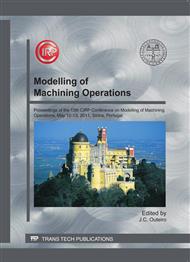[1]
M.C. Shaw: Metal cutting principles (Oxford Univ. Press, Oxford 1984).
Google Scholar
[2]
K. Nakayama: Bull. Fac. Eng. Yokohama Natl. Univ. Japan Vol. 8 (1959), p.1.
Google Scholar
[3]
E.D. Doyle, J.G. Horne and D. Tabor: Proc. R. Soc. Lond. A. Math. Phys. Sci. Vol. 366 (1979), p.173.
Google Scholar
[4]
V. Madhavan, S. Chandrasekar and T.N. Farris: J. Tribol. Vol. 124 (2002), p.617.
Google Scholar
[5]
L. De Chiffre: Int. J. Mach. Tool Des. Res. Vol. 17 (1977), p.225.
Google Scholar
[6]
C. Huang, S. Lee, J.P. Sullivan and S. Chandrasekar: Tribol. Lett. Vol. 28-1 (2007), p.39.
Google Scholar
[7]
S. Tobias and W. Fishwick: Trans ASME Vol. 80 (1958), p.1079.
Google Scholar
[8]
S. Doi and S. Kato: Trans ASME Vol. 78 (1956), p.1127.
Google Scholar
[9]
H. Findley, US Patent 3,174,404. (1965)
Google Scholar
[10]
J. Kumabe: Vibration cutting – basic principle and application (Jikkyo Shuppan Books, Japan 1979).
Google Scholar
[11]
W. Moscoso, E. Olgun, W.D. Compton and S. Chandrasekar: J. Tribol. Vol. 127 (2005), p.238.
Google Scholar
[12]
P.N. Chhabra, B. Ackroyd, W.D. Compton and S. Chandrasekar: Proc. Inst. Mech. Eng. B: J. Eng. Manuf. Vol. 216 (2002), p.321.
Google Scholar
[13]
J.B. Mann, C. Saldana, W. Moscoso, W.D. Compton and S. Chandrasekar: Tribol. Lett. Vol. 35-3 (2009), p.221.
Google Scholar
[14]
T. Moriwaki and E. Shamoto: Ann. CIRP Vol. 40-1 (1991), p.559.
Google Scholar
[15]
J.B. Mann, S. Chandrasekar and W.D. Compton, US Patent 7,587,965. (2009)
Google Scholar
[16]
J.B. Mann, C. Saldana, S. Chandrasekar, W.D. Compton and K.P. Trumble: Scr. Mater. Vol. 57-10 (2007), p.909.
Google Scholar
[17]
J.B. Mann, S. Chandrasekar and W.D. Compton, US Patent 7,628,099. (2009)
Google Scholar
[18]
C. Saldana: MS Thesis, Purdue University, US. (2006)
Google Scholar
[19]
S. Smith, B. Woody, W. Barkman and D. Tursky: Ann. CIRP Vol. 58-1 (2009), p.97.
Google Scholar
[20]
K.J. Stout, E.J. Davis and P. Sullivan: Atlas of machined surfaces (Chapman and Hall, UK 1990).
Google Scholar


